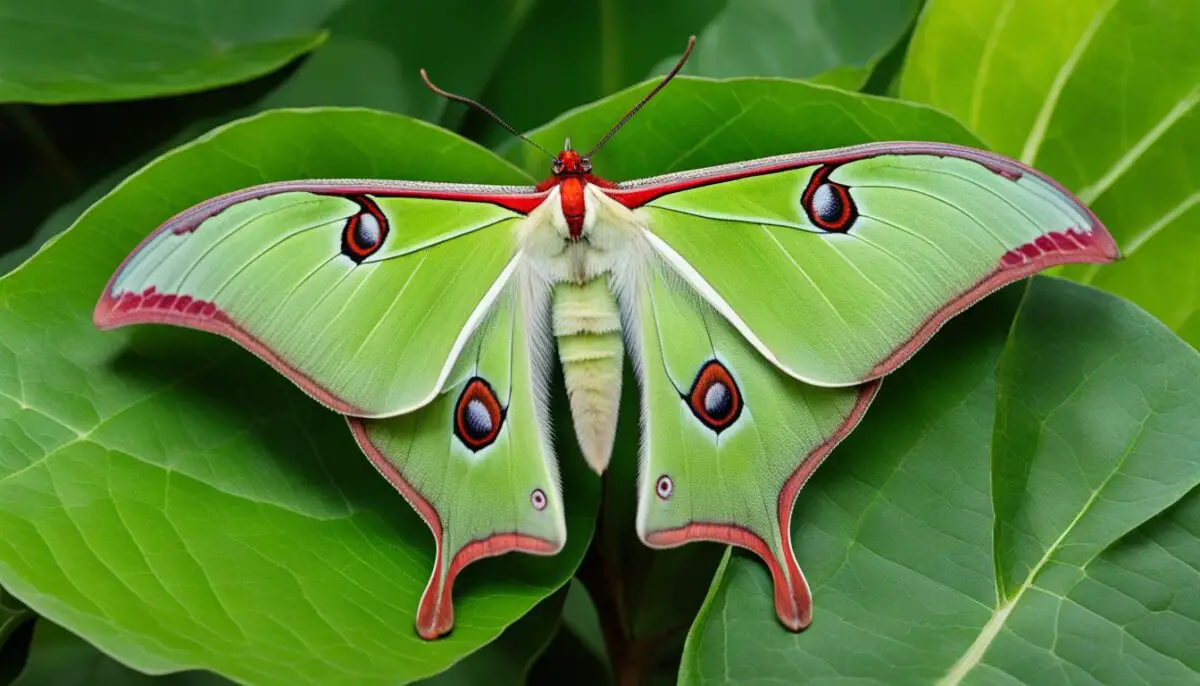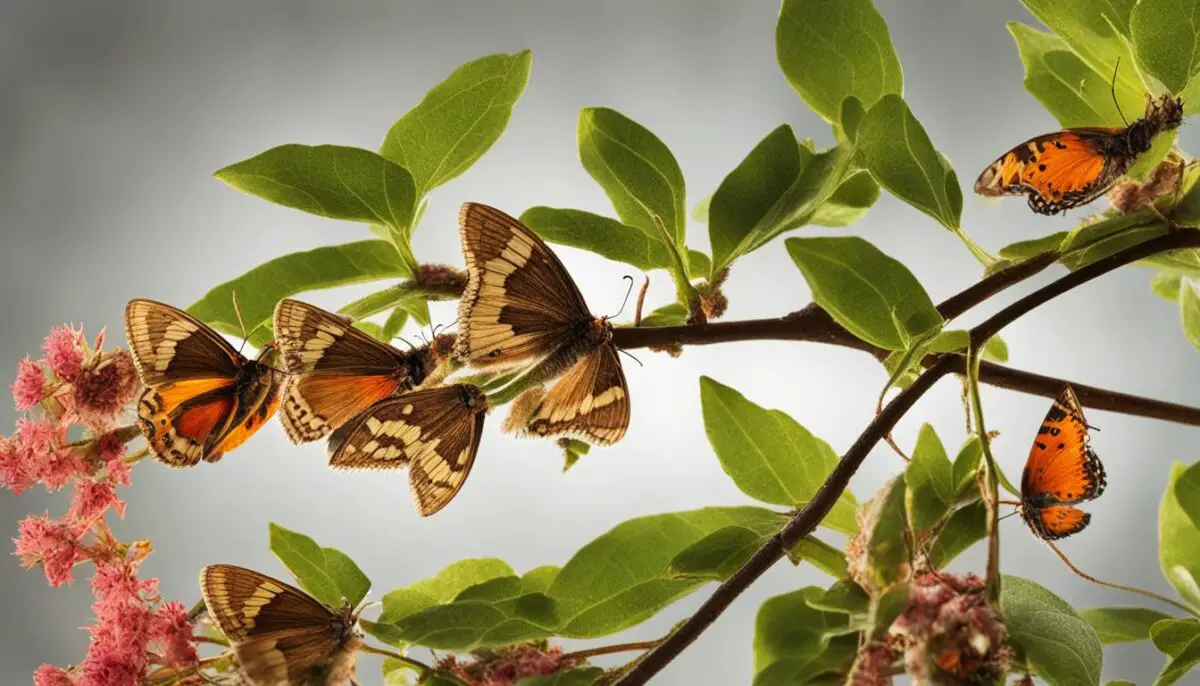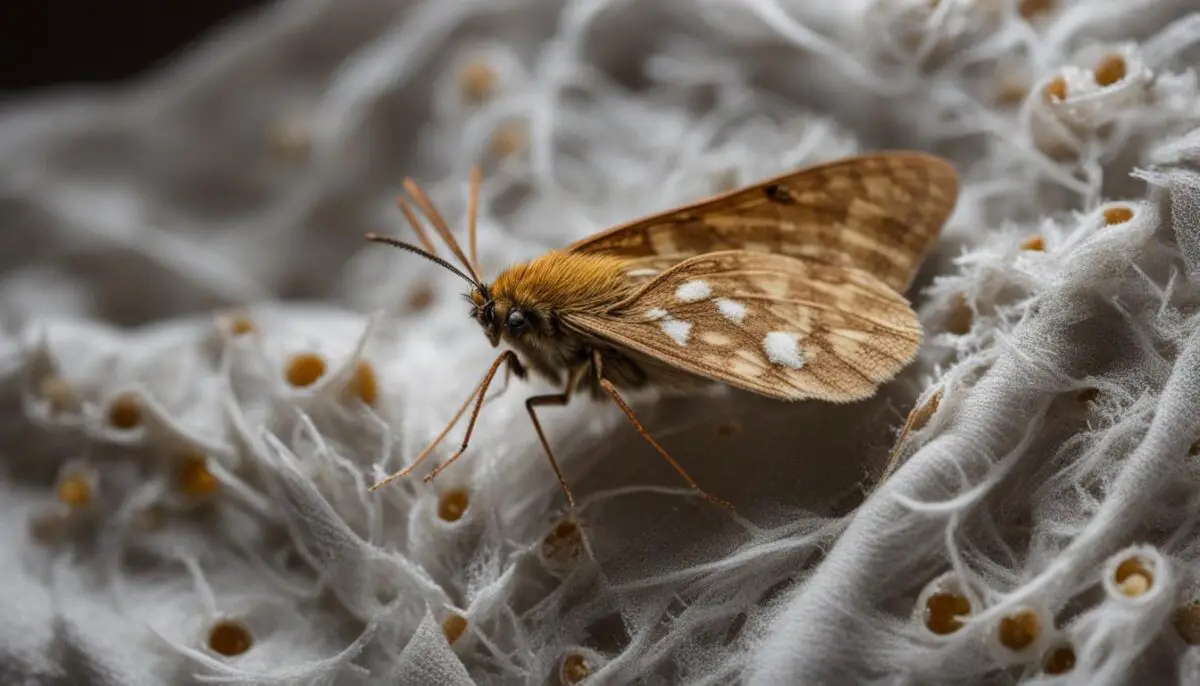Welcome to our article on the fascinating world of moths! In this section, we will explore the process of how moths lay eggs, shedding light on their intriguing lifecycle and reproduction. From the moment a female moth lays her eggs to the hatching of the larvae, we’ll discover the secrets behind these remarkable creatures.
The moth’s lifecycle is a complete metamorphosis, similar to that of butterflies. It all begins with the moth laying eggs, which hatch into larvae or caterpillars. These caterpillars feed on various plant materials, growing and transforming until they eventually form cocoons. Finally, adult moths emerge, ready to continue the cycle by laying their own eggs.
Understanding this egg-laying process is essential for studying the lifecycle of moths and developing effective methods for pest control. By gaining insights into where and how moths lay their eggs, we can better understand their behaviors and preferences.
Key Takeaways
- Moths undergo a complete metamorphic lifecycle, starting with the female moth laying eggs.
- The eggs hatch into larvae, also known as caterpillars, which feed on plant materials.
- Caterpillars eventually form cocoons and emerge as adult moths.
- Understanding how moths lay eggs is crucial for studying their lifecycle and developing effective pest control methods.
- Moths have different reproductive behaviors and preferences for egg-laying sites.
The Diversity of Moths
When it comes to moths, the diversity is truly remarkable. These fascinating insects come in a wide range of species, each with its own unique characteristics, behaviors, and habitats. Let’s explore some of the major types of moths that lay eggs and uncover their fascinating world.
One of the most mesmerizing types of moths is the Luna moth. With its delicately green wings and long, elegant tails, the Luna moth is a sight to behold. Another remarkable species is the Hummingbird Hawk moth, which, as the name suggests, resembles a hummingbird in flight and feeds on nectar. If you’re looking for sheer size, the Atlas moth won’t disappoint. As one of the largest moth species in the world, it boasts impressive wing patterns that can span up to 12 inches in diameter.
For those who appreciate vibrant colors, the Rosy Maple moth is a treat. These small and brightly colored moths can be found near maple trees, adding a pop of beauty to the surroundings. On the other hand, the Gypsy moth is known for its invasive nature and its ability to defoliate trees.
“The diversity of moths is truly astonishing. From the striking Skull-like patterns of the Death’s Head Hawk moth, to the impressive wingspans of Cecropia moths, each species has its own unique charm.”
Tiger moths are another diverse group, known for their vibrant colors and striking patterns. Meanwhile, the existence of Poodle moths remains a bit mysterious, with controversy still surrounding their taxonomy and classification. The Sphinx moth, often called the “hawk moth” or “hummingbird moth,” is famous for its rapid flight and ability to hover while feeding.

Another visually striking species is the Giant Leopard moth, with its captivating black and white spotted wings. Meanwhile, the American Dagger moth boasts dagger-shaped markings on its wings and has caterpillars that can cause skin irritation.
Some moths are notorious pantry pests, such as the Indian Meal moth and Grain moth, which infest stored grains and food products. On the other hand, Silkworm moths are celebrated for their role in silk production. If you’re looking for a truly fascinating caterpillar, the Hickory Horned Devil moth has one of the largest and most distinctive larvae in North America.
As you might have guessed, moths aren’t always the best dinner companions. Miller moths can be quite the nuisance when they swarm around outdoor lights, while Tarantula moths have evolved bright orange and black coloration to mimic tarantula spiders as a defense mechanism. And let’s not forget the venomous caterpillars of Asp moths, which deliver painful stings.
All these examples showcase just a fraction of the immense diversity and beauty of moths. With their unique characteristics and ecological roles, moths play an important part in our natural world.
Describing the Appearance of Moths
Moths are fascinating insects known for their distinct appearance and unique characteristics. Let’s explore the various aspects of a moth’s physical features:
Moth Body:
A moth’s body is divided into three main parts: the head, thorax, and abdomen. This segmentation provides flexibility and allows for efficient movement.
Moth Wings:
One of the most defining features of moths is their wings. They have two pairs of membranous wings that are covered in scales. These scales give moths their characteristic coloration and intricate patterns. From drab and cryptic to vibrant and iridescent, the colors of moth wings vary greatly across different species.
Moth Antennae:
Moths have long antennae, which can be feathery or filamentous in appearance. These antennae serve as sensory organs, helping moths detect chemicals and environmental cues in their surroundings.
Moth Proboscis:
One of the distinguishing features of moths is their long, tubular mouthpart called a proboscis. This adaptation allows moths to feed on nectar from flowers and other liquid food sources.
Moth Legs:
M\nMoths have six legs attached to their thorax, which they use for walking, climbing, and gripping different surfaces.
Moth Eyes:
Moths have large compound eyes that provide them with good vision. These compound eyes enable them to navigate their surroundings and detect visual cues.
Moth Sexual Dimorphism:
In some moth species, there is a noticeable difference in characteristics between males and females. This is known as sexual dimorphism. Males and females may differ in size, wing shape, and coloration. These differences often play a role in mating behaviors and species identification.
Moth Caterpillars:
Moths begin their lives as larvae, commonly known as caterpillars. These caterpillars have a segmented body covered in tiny hairs. They come in a variety of colors and patterns, some even bearing intimidating appearances to deter predators.
| Moth Appearance | Description |
|---|---|
| Body | Divided into head, thorax, and abdomen |
| Wings | Two pairs of membranous wings covered in scales |
| Antennae | Long and often feathery or filamentous |
| Proboscis | Long tubular mouthpart for feeding on nectar |
| Legs | Six legs attached to the thorax |
| Eyes | Large compound eyes for good vision |
| Sexual Dimorphism | Differences in size, wing shape, and coloration between males and females |
| Caterpillars | Segmented body covered in tiny hairs, varying colors and patterns |
Moths possess a wide range of physical characteristics, making them an intriguing group of insects. From their distinct body structure and intricate wing patterns to their feathery antennae and long proboscis, every aspect of a moth’s appearance serves a specific purpose in their survival and reproduction.

Moth Lifecycle Summary
| Stage | Description | Duration |
|---|---|---|
| Egg | Moth lays eggs in suitable locations | Varies by species |
| Larva (Caterpillar) | Hatched eggs develop into caterpillars consuming plant material | Varies by species and environmental conditions |
| Pupa (Chrysalis or Cocoon) | Caterpillars undergo transformation inside a cocoon or chrysalis | Varies by species and environmental conditions |
| Adult | Fully developed moths with reproductive capabilities emerge | Varies by species |
The lifecycle of moths involves a remarkable journey of transformation, from a tiny egg to a magnificent flying insect. Each stage plays a crucial role, contributing to the survival and reproduction of these fascinating creatures. Understanding the lifecycle of moths not only provides insights into their biology but also helps us appreciate the intricate beauty and resilience of nature.
Moth Infestations and Damage
Moths can be a nuisance in homes and businesses, causing damage to fabrics and materials made of natural fibers. It’s essential to understand the signs of moth infestations, as well as preventive measures and extermination methods to protect your belongings.
Signs of Moth Infestations
- Holes in fabric or clothing: Moths lay their eggs on fabric and the feeding larvae can create small holes, particularly in wool, silk, and other natural fibers.
- Powdery substance: Accumulation of a white or beige powdery substance around clothing or fabric can indicate the presence of moth larvae.
- Silk webbing: Some moth species, like clothes moths, create silk webbing as they feed and move around your belongings.
Prevention of Moth Infestations
To prevent moth infestations, follow these tips:
- Store fabrics properly: Keep clothing and textiles in airtight containers or sealed bags to prevent access for adult moths and to contain larvae if an infestation occurs.
- Regularly clean and inspect: Regularly vacuum and clean closets, basements, and other storage areas to remove moth eggs or larvae.
- Maintain screens and seal cracks: Ensure screens in windows and doors are intact to prevent moths from entering your home. Seal any cracks or gaps where moths might find entry.
- Outdoor lighting: Reduce moth attraction by keeping outdoor lights off or using yellow bulbs, as moths are less attracted to this color of light.
Moth Extermination Methods
If you suspect a moth infestation, it is crucial to act quickly to prevent further damage. Consider the following moth extermination methods:
- Professional extermination services: If the infestation is severe or persists despite preventive measures, it may be necessary to seek professional help to eliminate the problem.
- Cleaning and laundering: Thoroughly clean affected areas, launder infested clothing in hot water, and use dryer heat to kill any eggs or larvae.
- Natural deterrents: Some natural remedies, such as using cedar chips, lavender sachets, or mothballs, can deter moths. However, be cautious with mothballs as they contain potentially harmful chemicals.
Regular cleaning, proper storage, and vigilance are key to preventing moth infestations and minimizing damage. By implementing preventive measures and taking prompt action at the first signs of infestation, you can protect your fabrics and belongings from moth-related harm.

How Long Do Moths Live?
The lifespan of moths can vary depending on factors such as species, climate, and mating behaviors. Most adult moths live for about one to two weeks without food before starving. However, some larvae can enter a hibernation-like state called diapause and survive for months without food. The adult stage of small moth species may only last two to three days, while larger species can live several months. Male and female moths generally have similar lifespans, although there can be slight differences in the duration of the adult stage. Moths go through multiple generations per year, with different life spans depending on environmental conditions and availability of mates.
Shortest Moth Life Span
The shortest moth life span is observed in small moth species, where the adult stage typically lasts only two to three days. These species often have accelerated life cycles, with brief but intense periods of activity and reproduction.
Male and Female Moth Life Span
Male and female moths generally have similar lifespans, experiencing the same duration for the adult stage. However, there can be slight variations depending on the species and specific environmental conditions.
| Moth Species | Male Moth Life Span | Female Moth Life Span |
|---|---|---|
| Species A | 1-2 weeks | 1-2 weeks |
| Species B | 2-3 months | 2-3 months |
| Species C | 3-4 weeks | 3-4 weeks |
Moth lifespans can vary greatly depending on the species, with some living only for a few days, while others can survive for several months. Environmental conditions, availability of food, and mating opportunities also play a significant role in determining the duration of a moth’s life.
Conclusion
Moths are fascinating insects that undergo a complete metamorphic life cycle, starting with eggs laid by the female moth. With their diverse appearances, including unique body structures, wing patterns, and coloration, moths can be found in various habitats, from gardens and flowerbeds to areas with outdoor lighting. These nocturnal creatures play important ecological roles as pollinators and serve as a vital food source for many animals.
However, moths can also be pests, causing damage to fabrics and materials. Understanding their life cycle and behaviors is crucial for effective pest control and conservation efforts. By knowing how moths lay eggs and develop into larvae, pupae, and adults, we can better prevent infestations and minimize potential damage to our belongings.
The lifespan of moths varies depending on species and environmental factors, with most adults living for a few weeks to a few months. Implementing preventive measures, such as regular cleaning and storage of fabrics, can help minimize moth infestations. Conservation efforts are also important to protect different moth species from threats like habitat loss and climate change.
From their diverse appearances to their ecological roles and pest potential, moths are truly fascinating creatures. By learning more about their behavior, habitats, and life cycle, we can coexist with moths while ensuring the protection of our belongings and the preservation of these unique insects in the wild.
FAQ
What is the life cycle of a moth?
Moths undergo a complete metamorphic life cycle consisting of four stages: egg, larva (caterpillar), pupa (chrysalis or cocoon), and adult.
What are some major types of moths?
Some major types of moths include Luna moths, Hummingbird Hawk moths, Atlas moths, Rosy Maple moths, Gypsy moths, and Death’s Head Hawk moths.
How do moths reproduce?
Moths reproduce by laying eggs in suitable locations, usually in dark and protected areas.
What do moths look like?
Moths have a distinct body structure with three main parts: the head, thorax, and abdomen. They have two pairs of membranous wings covered in overlapping scales and long antennae.
Where do moths lay their eggs?
Moths lay their eggs in dark and protected places, such as the back of closets or other hidden areas.
What is the lifespan of a moth?
The lifespan of moths varies depending on the species, with most adults living for a few weeks to a few months.
How can I prevent moth infestations?
To prevent moth infestations, it is crucial to store fabrics properly, ensure screens on windows and doors are intact, and keep outdoor lights off or use yellow bulbs to reduce moth attraction.
How long can moths live without food?
Most adult moths can live for about one to two weeks without food before starving.
